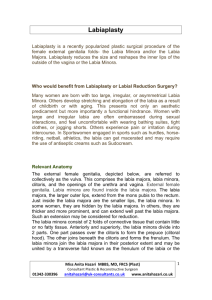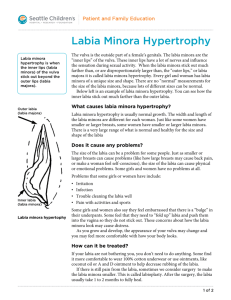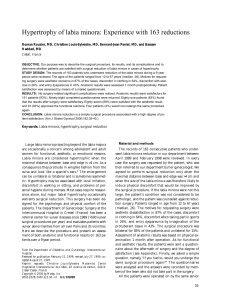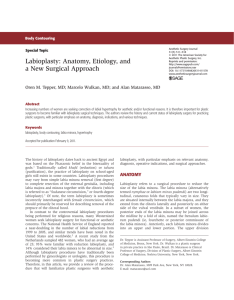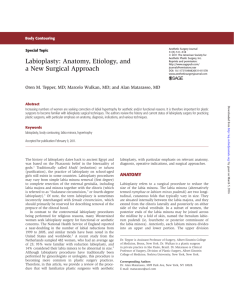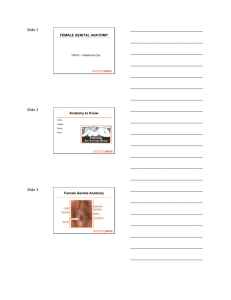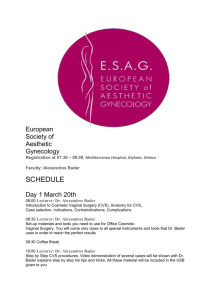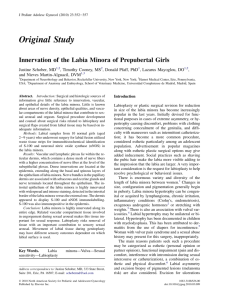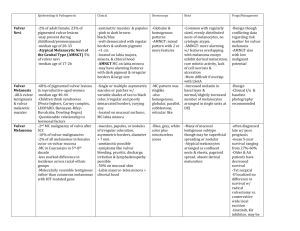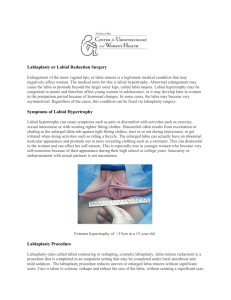Hypertrophic Labia Minora
advertisement
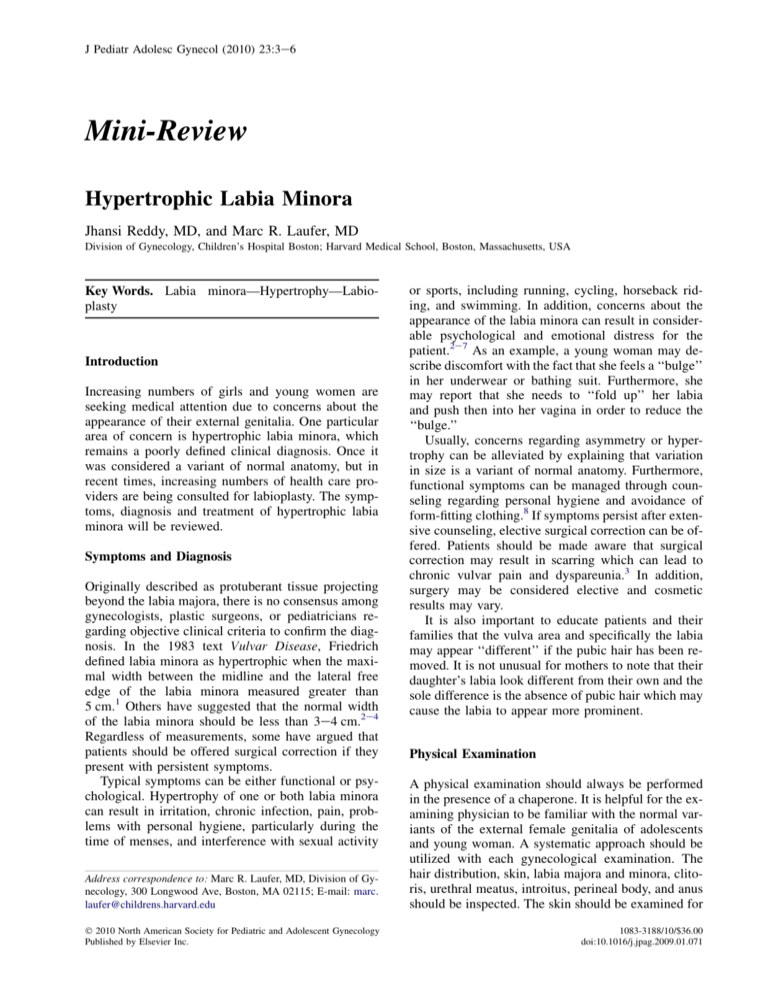
J Pediatr Adolesc Gynecol (2010) 23:3e6 Mini-Review Hypertrophic Labia Minora Jhansi Reddy, MD, and Marc R. Laufer, MD Division of Gynecology, Children’s Hospital Boston; Harvard Medical School, Boston, Massachusetts, USA Key Words. Labia minora—Hypertrophy—Labioplasty Introduction Increasing numbers of girls and young women are seeking medical attention due to concerns about the appearance of their external genitalia. One particular area of concern is hypertrophic labia minora, which remains a poorly defined clinical diagnosis. Once it was considered a variant of normal anatomy, but in recent times, increasing numbers of health care providers are being consulted for labioplasty. The symptoms, diagnosis and treatment of hypertrophic labia minora will be reviewed. Symptoms and Diagnosis Originally described as protuberant tissue projecting beyond the labia majora, there is no consensus among gynecologists, plastic surgeons, or pediatricians regarding objective clinical criteria to confirm the diagnosis. In the 1983 text Vulvar Disease, Friedrich defined labia minora as hypertrophic when the maximal width between the midline and the lateral free edge of the labia minora measured greater than 5 cm.1 Others have suggested that the normal width of the labia minora should be less than 3e4 cm.2e4 Regardless of measurements, some have argued that patients should be offered surgical correction if they present with persistent symptoms. Typical symptoms can be either functional or psychological. Hypertrophy of one or both labia minora can result in irritation, chronic infection, pain, problems with personal hygiene, particularly during the time of menses, and interference with sexual activity or sports, including running, cycling, horseback riding, and swimming. In addition, concerns about the appearance of the labia minora can result in considerable psychological and emotional distress for the patient.2e7 As an example, a young woman may describe discomfort with the fact that she feels a ‘‘bulge’’ in her underwear or bathing suit. Furthermore, she may report that she needs to ‘‘fold up’’ her labia and push then into her vagina in order to reduce the ‘‘bulge.’’ Usually, concerns regarding asymmetry or hypertrophy can be alleviated by explaining that variation in size is a variant of normal anatomy. Furthermore, functional symptoms can be managed through counseling regarding personal hygiene and avoidance of form-fitting clothing.8 If symptoms persist after extensive counseling, elective surgical correction can be offered. Patients should be made aware that surgical correction may result in scarring which can lead to chronic vulvar pain and dyspareunia.3 In addition, surgery may be considered elective and cosmetic results may vary. It is also important to educate patients and their families that the vulva area and specifically the labia may appear ‘‘different’’ if the pubic hair has been removed. It is not unusual for mothers to note that their daughter’s labia look different from their own and the sole difference is the absence of pubic hair which may cause the labia to appear more prominent. Physical Examination Address correspondence to: Marc R. Laufer, MD, Division of Gynecology, 300 Longwood Ave, Boston, MA 02115; E-mail: marc. laufer@childrens.harvard.edu A physical examination should always be performed in the presence of a chaperone. It is helpful for the examining physician to be familiar with the normal variants of the external female genitalia of adolescents and young woman. A systematic approach should be utilized with each gynecological examination. The hair distribution, skin, labia majora and minora, clitoris, urethral meatus, introitus, perineal body, and anus should be inspected. The skin should be examined for Ó 2010 North American Society for Pediatric and Adolescent Gynecology Published by Elsevier Inc. 1083-3188/10/$36.00 doi:10.1016/j.jpag.2009.01.071 4 Reddy and Laufer: Hypertrophic Labia Minora Fig. 1. Bilateral labial hypertrophy fully extended (with permission from Emans, Laufer, Goldstein: Pediatric and Adolescent Gynecology, (5th ed.). Lippincott, Williams, Wilkins, 2005, p 351). dermatologic abnormalities such as lichen sclerosus, vulvitis, cysts, lipomas, childhood asymmetric labium majus enlargement (CALME) or abscesses.9 The labia minora should be fully extended, evaluated for asymmetry and measured from the midline to the lateral free edge (Fig. 1).5 Timing of Treatment The majority of young adolescents requesting an evaluation for labial hypertrophy need reassurance that their anatomy is normal and there is no need for concern. Concern for abnormal appearance is highest when younger adolescents are insecure regarding their body self-image. The goal of labioplasty is resection of the hypertrophic labial tissue and the creation of symmetrically reduced labia. Labioplasty can be performed in adolescence. Some have advocated that the minimum age should be between 15 and 16 years to avoid the need for a second procedure in the event that the labia continue to grow, and to proceed at a time when the young woman is more mature and able to participate in informed consent. Decisions regarding surgical correction in adolescence should always involve the parent or guardian. Fig. 2. Resection of the excess labial tissue using the straight amputation technique (with permission from Emans, Laufer, Goldstein: Pediatric and Adolescent Gynecology, (5th ed.). Lippincott, Williams, Wilkins, 2005, p352). although this has rarely been seen. The ‘‘natural contour’’ of the labia minora may be lost, and the relationship of labial tissue to the clitoral hood may change with the reduction procedure. Great care should be taken during surgery to avoid the area of the clitoris and clitoral hood. Several newer techniques have been described that attempt to preserve the natural shape of the labia minora and to reduce the amount of exposed scar tissue.2 One such technique involves a wedge resection with subsequent reanastomosis.2 While maintaining symmetry, a V-shaped segment is first identified and then resected (Fig. 3).2 The raw edges are then reapproximated using interrupted or a running subcuticular fine absorbable suture (Fig. 4).2e4 Postoperatively, patients should keep the area clean and dry, avoid strenuous activity, and wear loose clothing to protect the Treatment Several techniques have been described in the literature. The simplest technique involves straight amputation of the protuberant tissue and oversewing the edge (Fig. 2).5,10 This technique is the one that is most utilized in our practice and has the easiest recovery period. With this technique, however, the labial edge may theoretically be replaced with a scarred suture line that can cause chronic irritation and discomfort, Fig. 3. Planned resection of the excess labial tissue using the V-shaped wedge technique. The lines mark the area for excision and the arrows show how the edges will be reapproximated (with permission from Emans, Laufer, Goldstein: Pediatric and Adolescent Gynecology, (5th ed.). Lippincott, Williams, Wilkins, 2005, p 352). Reddy and Laufer: Hypertrophic Labia Minora 5 discomfort. There were no major surgical complications. Of note, 11 patients (7%) underwent a second procedure because of a small wound dehiscence. Overall, the results of this study suggest that labioplasty is a simple surgical procedure that can be associated with a high degree of patient satisfaction.3 Summary and Recommendations Fig. 4. Following resection of the excess labial tissue using the V-shaped wedge technique, the normal contour of the labia is preserved (with permission from Laufer MR, Galvin WJ: Adolescent and Pediatric Gynecology, 1995, p 40). vulvar area from friction. At the two-week postoperative visit, the labia should appear symmetric, well healed, and with minimal exposed scar tissue (Fig. 5).2 The largest study to date of women who underwent labioplasty reported favorable results.3 The most common motives for surgical correction included esthetic complaints, discomfort with certain types of clothing, entry dysparenuia, and difficulty participating in athletic activities. The majority of subjects underwent bilateral surgical correction and a V-shaped wedge resection technique was utilized. Of the 163 patients, 91% of patients reported an improvement in esthetic appearance and 96% reported a relief in functional Hypertrophic labia minora is often described as protuberant labial tissue that extends beyond the labia majora. There are no standard diagnostic criteria to confirm the diagnosis. Physicians routinely use labial width measurements and the presence of symptoms to guide treatment options. Common symptoms include irritation, pain, chronic infection, problems with personal hygiene and interference with sexual activity or sports. In addition, concerns about the appearance of the labia minora can result in considerable psychological and emotional distress. Usually, concerns regarding asymmetry or hypertrophy can be alleviated by explaining that variation in size is a variant of normal anatomy. Most symptoms can be conservatively managed with counseling regarding personal hygiene and avoidance of form-fitting clothing. Surgical correction should be offered for persistent symptoms in the fully developed adolescent. Patients should be extensively counseled that surgical correction may lead to scarring, chronic vulvar pain, and dyspareunia. In addition, surgery is considered elective and cosmetic results may vary. The goal of labioplasty is resection of the hypertrophic labial tissue and the creation of symmetrically reduced labia. We typically utilize the straight amputation technique, but the V-shaped wedge resection is the most studied and published technique. References Fig. 5. The labia appear well healed and with minimal scarring at the 2 week post-operative visit (with permission from Laufer MR, Galvin WJ: Adolescent and Pediatric Gynecology, 1995, p 41). 1. Friedrich EG: Vulvar Disease, (2nd ed.). Philadelphia, W.B. Saunders, 1983 2. Laufer MR, Galvin WJ: Labia hypertrophy: a new surgical approach. Adolesc Pediatr Gynecol 1995; 8:39 3. Rouzier R, Louis-Sylvestre C, Paniel BJ, et al: Hypertrophy of labia minora: experience with 163 reductions. Am J Obstet Gynecol 1999; 182:35 4. Munhoz AM, Filassi JR, Ricci MD, et al: Aesthetic labia minora reduction with inferior wedge resection and superior pedicle flap reconstruction. Plast Reconstr Surg 2006; 118:1237 5. Emans SJ, Laufer MR, Goldstein D: Pediatric and Adolescent Gynecology, (5th ed.). Philadelphia, Lippincott Williams and Wilkins, 2005 6. Alter G: A new technique for aesthetic labia minora reduction. Ann Plast Surg 1998; 40:287 6 Reddy and Laufer: Hypertrophic Labia Minora 7. Kato K, Kondo A, Gotoh M, et al: Hypertrophy of labia minora in myelodysplastic women. Labioplasty to ease clean intermittent catheterization. Urology 1988; 31:294 8. Radman H: Hypertrophy of the labia minora. Obstet Gynecol 1976; 48(1 Suppl):78S 9. Vargas SO, Kozakewich HP, Boyd TK, et al: Childhood asymmetric labium enlargement, mimicking a neoplasm. Am J Surg Pathol 2005; 29:1007 10. Hodgkinson DJ, Hait G: Aesthetic vaginal labioplasty. Plast Reconstr Surg 1984; 74:414

